October 18, 1979
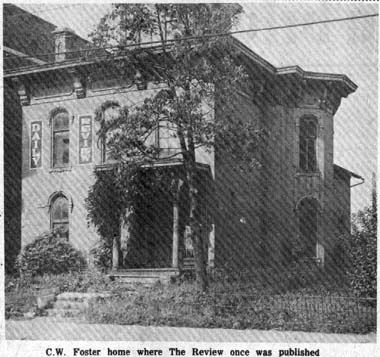
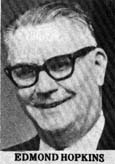

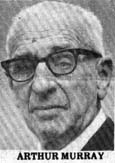
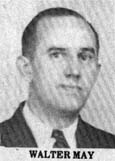
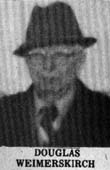
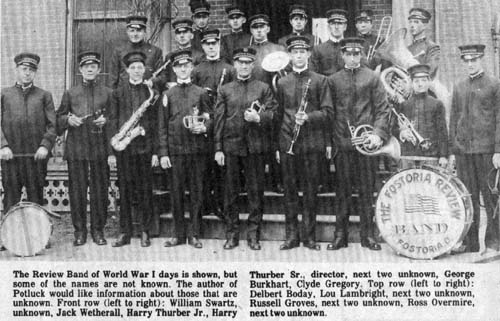
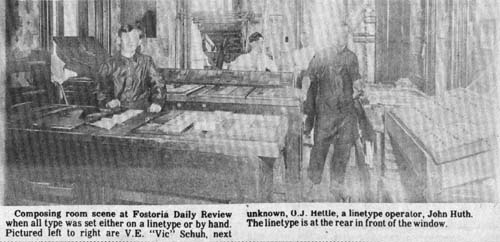
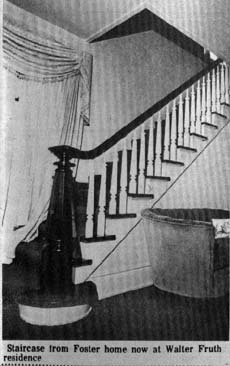
Picture #1 – C.W. Foster home where The Review once was published.
Picture #2 – Edmond Hopkins
Picture #3 – Marie (Livingston) Forrest
Picture #4 – Arthur Murray
Picture #5 – Walter May
Picture #6 – Douglas Weimerskirch
Picture #7 – The Review Band of World War I days is shown, but some of the names are not known. The author of Potluck would like information about those that are unknown. Front row (left to right): William Swartz, unknown, Jack Wetherall, Harry Thurber Jr., Harry Thurber Sr., director, next unknown, George Burkhart, Clyde Gregory. Top row (Left to right): Delbert Boday, Lou Lambright, next two unknown, Russell Groves, next two unknown, Ross Overmire, next two unknown.
Picture #8 – Composing room scene at Fostoria Daily Review when all type was set on a linetype or by hand. Pictured left to right are V.E. “Vic” Schuh, next unknown, O.J. Hettle, a linetype operator, John Huth. The linetype is at the rear in front of the window.
Picture #9 – Staircase from Foster home now at Walter Fruth residence.
The C.W. Foster Home on South Main Street, which at one time occupied the site of the present municipal building, and the Fostoria Daily Review, and its employees which occupied the old home for a number of years, is the subject of today’s story. It is a story I have had on my list to do, and had intentions of writing it a year or more ago. Procrastination has resulted in two of the people, who would have been part of it, passing away in the meantime.
One of the reasons I have been anxious to do the story about the old Foster house is because that is where I got my start, as a boy in the business world. I have fond memories of the house and the grounds surrounding it, and the people who worked at The Review.
The Foster house was the home of C.W. Foster, father of Charles “Calico” Foster, who later became governor of Ohio and still later secretary of the U.S. Treasury.
The Review started out as the Fostoria News in 1860, as a weekly. It changed hands and location a number of times. In 1876, O.J. and J.P. De Wolfe, acquired the paper. Later H.J. Lockhart became managing editor and John, his son, news editor. About that time it became a daily.
REVIEW THERE IN 1907
In 1907, the old Foster house was leased, the Foster family having passed away, and the newspaper moved in from the previous location on West Tiffin Street. A reorganization resulted in John Lockhart becoming managing editor and holder of controlling interest.
In 1913, F.M. Hopkins purchased Lockhart’s interest in the paper. Later John Lockhart became editor of The Times. The Hopkins family came to Fostoria from Toledo where he had editorial staff positions on Toledo News-Bee, Toledo Blade and Toledo Times.
My introduction to the newspaper and the Foster home was when I became a carrier boy in 1917, (I believe) when Clayton Kinsey was circulation manager.
In addition to carrying papers, I also helped Emma Reber in the mailroom. And, I won’t forget working one summer in the basement foundry where the linotype metal was remelted daily and formed into ingots for reuse. It was a terrific job for a boy like me to undertake, being undersized and pretty lean.
On Armistice Day 1919, I passed out an Extra Edition about the end of World War I, and took part in the celebration. The population went wild. Oldtimers will remember that day.
The old Foster home was quite a structure. Too bad it was demolished…it should have become Fostoria’s number one historic site and museum, since the Foster family played such an important part in the town’s early days.
REVIEW MODED IN 1920
The double front doors of the Foster home led to the second floor editorial department via a beautiful staircase; or to the left, led into the business office, which was once the parlor of the Fosters.
When The Review acquired a larger and more adequate building in 1920 on East Center Street, where The Review Times is now, the Foster house was demolished, but the old front entry staircase was salvaged and installed in the Bill Daub home at 836 N. Union St., where the Walter Fruths now reside.
I used the front stairs in the old house many times later, when Art Murray worked in the editorial department for a year, starting in 1920. Art took an interest in me, as a newspaper carrier, and hired me to assist him collect news in the business district, paying me out of his own pocket the large sum of $2 per week. After soliciting the news items, Art taught me how to organize them into paragraphs, and type them on one of the old typewriters.
Looking at the accompanying photo of the Foster home, the reader will locate the editorial room by looking at the first group of windows on the right of the second floor. The room was undoubtedly a bedroom when the Fosters lived there.
There was plenty of space on the second floor and the Review Band practiced up there. “W.F.W.” was always interested in bands…not only the Review Band, but Wainwright’s in later years.
Emma Reber, the longest continually employed individual at The Review and eventually The Review Times, had her mail room and bindery department on the second floor, reached by a back stairs or a hallway from the front stairs. If my memeory serves me correctly, there were four large upstairs rooms.
The accompanying photos show views of the compsing room which was located on the first floor back of the business office. In earlier days it must have been the Foster’s kitchen and dining room area.
The linotype machine sat in the baywindow of the composing room, which is the first floor window in the right of the photo.
PEOPLE WHO WORKED THERE
Some of the people who worked there 65 years ago were: Frank Daubel, John Huth, C.C. Crawford, Carl Hart, Norris Reed, Orville Stinchcomb (brother of Pete, a suburb football player who starred at FHS and for Ohio State), Florennce Ziegman (Burns), Ella McNally (Aldrich), Emma Reber, Vic Schuh, Otto Hettle, Nate Alvord, Earl Myers, Art Winkler, Paul Ayres, Walter May, Doug Weimerskirch, Ed Hopkins, Art Murray, Marie Livingston (Forrest), Paul Krupp, Ted Nole. I hope I didn’t miss any.
In the accompanying photo are those that worked in the composing room, at least when the photo was taken. They have all died. Out of the above list the only ones still living are Art Murray, Ed Hopkins, Marie Livingston (Forrest) Doug Weimerskirch, Walter May, and Pual Krupp. Paul Ayres and Florence Ziegman (Burns) died about a year ago. Ed Hopkins is living at Autumnwood Home, Tiffin; Weimerskirch at Elks Home in Virginia; Marie Forrest at Lakewood; Art Murray at Wooster.
Frank Dauble became publisher of The Fremont Messenger.
Older readers will remember that Vic Schuh, in addition to being a printer, also wrote a sports column for The Review, called Abracadabra, and he signed it Raincheck. Vic’s grandson, Pay Magers, is sports editor of The Review Times. Vic would like that if he were living.
Governor Foster’s home was on West Tiffin Street. It too, finally demolished. Too bad! That whole area, where the two Foster properties were located was surrounded by an iron fence…on Main, Tiffin and the alley.
When Annie Foster, the last of the family passed away the property was deeded to the city of Fostoria and became known as Foster Park.
MANY MEMORIES
We carriers played on the lawns of both Foster properties while we waited for the paper to be printed. Most of those carriers moved away from Fostoria, and many have died. The only ones I know who are still living here are Delbert Kiser, Robert Munger, Glenn True, Layton Brown and this writer.
I have a lot of memories of those bygone days of the Foster properties…and the Review and its employees. Here are a few:
The Foster property when The Review was there, had lots of rats. One night “F.M.” left the lid off of his paste pot. The next morning a big fat rat was still in it. The paste tasted so good to the glutinous varmint that he devoured most if it, had increased in size, and couldn’t make his exit.
A photograph printed in The Review Times in 1954, showed the huge crowd that was on hand to hear President William Howard Taft speak on the front steps of The Review in 1913, he was campaigning. I was just a small boy then, but I remember standing on the fringe of the crowd, looking on, but of course not caring much about the speech. It was said that Major George Cunningham who introduced Taft talked longer than the speaker.
Before Florence Ziegman (Burns) passed away she told me that Paul Ayres, Art Winkler’s assistant fell into a drum of printers ink at The Review. What a sight he must have been. I was not present, not had I heard about it.
Many years after the Review Band no longer existed, I came into possession of one of the band hats. I later gave it to Sammy Winkler, son of Art. I don’t know if he still has it or not.
A possession I do have from The Review which came out of the old Foster home is an antique desk (without legs) with front dropleaf, a type which sits on top of a table. It was used by Vic Schuh in the composing room before my time and then by me later. It was finally discarded in favor of a fireproof enclosure for records and I carted it home. It is still in my basement, for what-nots and widgets.
I really meant for this story to be an expose about those still living who worked at The Review when it occupied the old Foster…I guess I got carried away into memories of the past. Anyway I hope you enjoyed it.